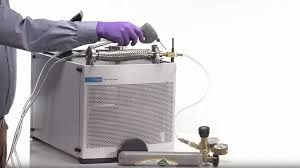Helium leak detectors play a crucial role in industries where even the smallest leaks can lead to major efficiency or safety concerns. From aerospace and refrigeration to semiconductor and automotive manufacturing, these devices are essential for maintaining system integrity and preventing losses. By using helium — an inert, non-toxic, and easily traceable gas — leak detection systems provide unmatched sensitivity and reliability compared to other methods.
As industries demand higher quality standards, understanding how helium leak detection works becomes vital for engineers, technicians, and manufacturers. This guide explains the fundamentals of helium leak detectors, their applications, technologies, and selection tips for businesses that prioritize precision and compliance.
How Helium Leak Detectors Work
Helium leak detectors operate on the principle of mass spectrometry. The process involves introducing helium gas into or around the test system. If a leak exists, helium molecules pass through and are detected by a mass spectrometer tuned specifically for helium’s atomic mass.
There are two main testing methods:
-
Vacuum Method: Used in sealed systems such as refrigeration, aerospace components, and medical devices.
-
Sniffer Method: Used in open systems like pipelines or tanks, where the detector “sniffs” for escaping helium around potential leak points.
This method offers high sensitivity — detecting leaks as small as 10⁻¹² mbar·L/s — making it ideal for critical operations.
Key Features of Helium Leak Detectors
Modern helium leak detectors come with advanced features for accuracy, automation, and efficiency:
-
High Sensitivity & Fast Response Time
-
Portable or Benchtop Configurations for flexible industrial use
-
Automatic Calibration and Data Logging
-
User-Friendly Interface with Digital Readouts
-
Integration with Robotic or Automated Systems
Applications Across Industries
Helium leak detectors are widely used in:
| Industry | Application |
|---|---|
| Aerospace & Defense | Testing jet engines, fuel systems, and vacuum chambers |
| Automotive | Checking air conditioning systems, fuel tanks, and braking components |
| Semiconductor | Ensuring vacuum integrity in wafer fabrication |
| Refrigeration & HVAC | Detecting micro-leaks in compressors and heat exchangers |
| Medical Devices | Leak testing catheters, implants, and sealed containers |
Advantages of Helium Leak Detection
-
Unmatched Sensitivity: Detects even microscopic leaks
-
Non-Flammable & Safe Gas: Helium is inert and environmentally safe
-
Accurate & Repeatable Results: Ideal for quality assurance and compliance testing
-
Reduces Maintenance Costs: Prevents system failures before they escalate
Selecting the Right Helium Leak Detector
When choosing a helium leak detector, consider these factors:
-
Type of Application: Vacuum or pressure-based testing
-
Detection Range: Sensitivity level required for your system
-
Mobility Needs: Portable vs. stationary units
-
Automation Compatibility: Integration with production lines
-
Budget and Maintenance Support
Emerging Trends in Helium Leak Detection
-
AI and IoT Integration: Predictive maintenance and data analytics are improving fault detection.
-
Helium Recovery Systems: Recycling helium to reduce operational costs.
-
Compact & Portable Designs: Easier use in field inspections.
-
Multi-Gas Detection: Combining helium with hydrogen or nitrogen for flexible testing.
Best Practices for Accurate Leak Detection
-
Always use certified helium gas for consistency.
-
Perform regular calibration of detectors.
-
Test under controlled environmental conditions to reduce noise.
-
Implement preventive maintenance schedules for long-term reliability.
Conclusion
Helium leak detectors are vital tools for ensuring safety, reliability, and performance in industries that rely on airtight systems. As technology advances, their precision and efficiency continue to improve, offering smarter, faster, and more sustainable leak detection solutions. Businesses that invest in quality helium leak detection systems enhance their operational integrity and maintain a competitive edge in quality assurance.